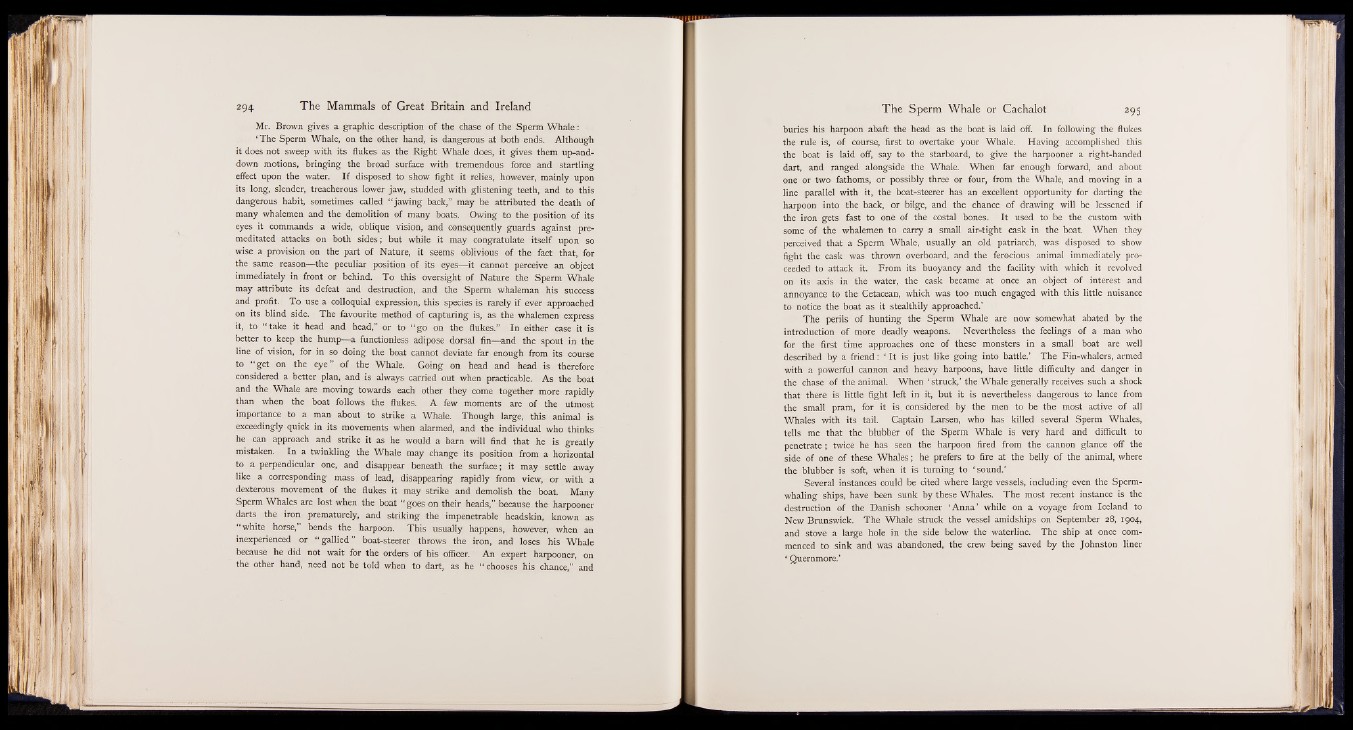
Mr. Brown gives a graphic description of the chase of the Sperm Whale:
‘ The Sperm Whale, on the other hand, is dangerous at both ends. Although
it does not sweep with its flukes as the Right Whale does, it gives them up-and-
down motions, bringing the broad surface with tremendous force and startling
effect upon the water. I f disposed to show fight it relies, however, mainly upon
its long, slender, treacherous lower jaw, studded with glistening teeth, and to this
dangerous habit, sometimes called “ jawing back,” may be attributed the death of
many whalemen and the demolition of many boats. Owing to the position of its
eyes it commands a wide, oblique vision, and consequently guards against premeditated
attacks on both sides; but while it may congratulate itself upon so
wise a provision on the part of Nature, it seems oblivious of the fact that, for
the same reason— the peculiar position of its eyes— it cannot perceive an object
immediately in front or behind. To this oversight of Nature the Sperm Whale
may attribute its defeat and destruction, and the Sperm whaleman his success
and profit. To use a colloquial expression, this species is rarely if ever approached
on its blind side. The favourite method of capturing is, as the whalemen express
it, to “ take it head and head,” or to “ go on the flukes.” In either case it is
better to keep the hump— a functionless adipose dorsal fin— and the spout in the
line of vision, for in so doing the boat cannot deviate far enough from its course
to “ get on the eye” of the Whale. Going on head and head is^«therefore
considered a better plan, and is always carried out when practicable. As the boat
and the Whale are moving towards each other they come together more rapidly
than when the boat follows the flukes. A few moments are of the utmost
importance to a man about to strike a Whale. Though large, this animal is
exceedingly quick in its movements when alarmed, and the individual who thinks
he can approach and strike it as he would a barn will find that he is greatly
mistaken. In a twinkling the Whale may change its position from a horizontal
to a perpendicular one, and disappear beneath the surface; it may settle away
like a corresponding mass of lead, disappearing rapidly from view, or with a
dexterous movement of the flukes it may strike and demolish the boat. Many
Sperm Whales are lost when the boat “ goes on their heads,” because the harpooner
darts the iron prematurely, and striking the impenetrable headskin, known as
“ white horse, bends the harpoon. This usually happens, however, when an
inexperienced or “ gallied ” boat-steerer throws the iron, and loses his Whale
because he did not wait for the orders of his officer. An expert harpooner, on
the other hand, need not be told when to dart, as he “ chooses his chance,” and
buries his harpoon abaft the head as the boat is laid off. In following the flukes
the rule is, of course, first to overtake your Whale. Having accomplished this
the boat is laid off, say to the starboard, to give the harpooner a right-handed
dart, and ranged alongside the Whale. When far enough forward, and about
one or two fathoms, or possibly three or four, from the Whale, and moving in a
line parallel with it, the boat-steerer has an excellent opportunity for darting the
harpoon into the back, or bilge, and the chance of drawing will be lessened if
the iron gets fast to one of the costal bones. It used to be the custom with
some of the whalemen to carry a small air-tight cask in the boat. When they
perceived that a Sperm Whale, usually an old patriarch, was disposed to show
fight the cask was thrown overboard, and the ferocious animal immediately proceeded
to attack it. From its buoyancy and the facility with which it revolved
on its axis in the water, the cask became at once an object of interest and
annoyance to the Cetacean, which was too much engaged with this little nuisance
to notice the boat as it stealthily approached.’
The perils of hunting the Sperm Whale are now somewhat abated by the
introduction of more deadly weapons. Nevertheless the feelings of a man who
for the first time approaches one of these monsters in a small boat are well
described by a friend: * It is just like going into battle.’ The Fin-whalers, armed
with a powerful cannon and heavy harpoons, have little difficulty and danger in
the chase of the animal. When ‘ struck,’ the Whale generally receives such a shock
that there is little fight left in it, but it is nevertheless dangerous to lance from
the small pram, for it is . considered by the men to be the most active of all
Whales with its tail. Captain Larsen, who has killed several Sperm Whales,
tells me that the blubber of the Sperm Whale is very hard and difficult to
penetrate; twice he has seen the harpoon fired from the cannon glance off the
side of one of these Whales; he prefers to fire at the belly of the animal, where
the blubber is soft, when it is turning to ‘ sound.’
Several instances could be cited where large vessels, including even the Spermwhaling
ships, have been sunk by these Whales. The most recent instance is the
destruction of the Danish schooner ‘ Anna’ while on a voyage from Iceland to
New Brunswick. The Whale struck the vessel amidships on September 28, 1904,
and stove a large hole in the side below the waterline. The ship at once commenced
to sink and was abandoned, the crew being saved by the Johnston liner
‘ Quernmore.’